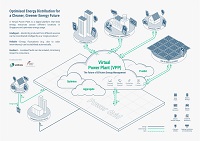For more information, please refer to:
A Singapore Government Agency WebsiteHow to identify
Official website links end with .gov.sg
Government agencies communicate via .gov.sg websites
(e.g. go.gov.sg/open).Trusted websites
Secure websites use HTTPS
Look for a lock ( )or https:// as an added precaution. Share sensitive information only on official, secure websites.
- The trial for a Solar Forecasting Model to anticipate solar intermittency and enhance Singapore’s power grid resilience has been successfully completed.
- Supported by the Energy Market Authority (EMA) and the Meteorological Service Singapore (MSS) of the National Environment Agency (NEA), and developed by the Solar Energy Research Institute of Singapore (SERIS) at the National University of Singapore (NUS), the model completed its one-year trial at EMA’s Power System Control Centre in September this year. First of its kind, the model is able to forecast Singapore’s island-wide solar irradiance[1] up to one hour ahead, with an average error rate[2] lower than 10%, one of the lowest for solar forecasting in the tropics.
- Unlike power generation plants, solar power generation cannot be moderated according to energy demand. Its power generation is dependent on Singapore’s tropical weather conditions which fluctuate depending on environmental factors such as cloud cover, rain, and humidity. This can lead to imbalances between electricity demand and supply output from solar photovoltaic (PV) systems.
- The Model would allow EMA, as Singapore’s power system operator, to anticipate the solar power output ahead of time and take pre-emptive actions to manage solar intermittency and balance the power grid. This is another step towards maintaining grid reliability as we scale-up solar deployment in Singapore. It also allows the electricity market to procure additional reserves or adjust the output of power generation plants and energy storage systems to increase electricity supply ahead of time to meet demand.
- “In tandem with the Singapore Green Plan 2030 and to advance Singapore’s energy transition, Singapore aims to deploy at least 2 gigawatt-peak (GWp) of solar capacity by 2030. A reliable solar forecasting model to predict solar irradiance, will enhance Singapore’s grid resilience and flexibility while supporting the deployment of additional solar capacity. This goes a long way in supporting our solar ambition and enhancing the resilience of our power grid.” said Mr Ngiam Shih Chun, Chief Executive, EMA.
- Dr Thomas Reindl, Deputy Chief Executive Officer at SERIS, who led the project team said: “Forecasting of solar irradiance is increasingly being required by Asian power grid operators from owners of large-scale solar power systems. Therefore, the developed model has strong potential to be scaled up and commercialised to support the operations of solar farms across the region.”
- Following the completion of the trial, EMA is upgrading its Energy Management System (EMS) to incorporate solar generation forecasts produced by the Solar Forecasting Model by 2023. These forecasts would also be provided to the Energy Market Company (EMC), Singapore’s wholesale electricity market operator, to be factored into the market clearing process to ensure more accurate dispatch schedules for power generators to meet power system demand. For more details, please refer to EMC website.
Annex A: Images of Solar Forecasting Model
[1]The Solar Forecasting Model utilises data from real-time irradiance sensors installed on rooftops of buildings and electrical substations across Singapore. It also incorporates numerous dynamic solar forecasting techniques such as satellite imagery and machine learning algorithms. Combining outputs from MSS’ numerical weather prediction system, known as SINGV, the Solar Forecasting Model is able to aggregate the various types of data to generate round-the-clock solar irradiance forecasts at regular intervals from 5 minutes to 24 hours ahead of schedules.
[2]The Solar Forecasting Model has a nRMSE (normalised root mean square error) of lower than 10% up to 1 hour ahead, on average.















